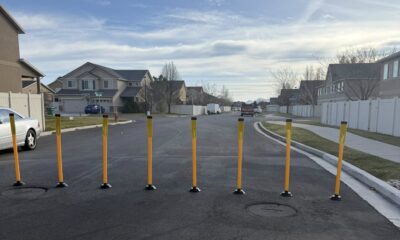Connect with us
Published
4 years agoon

Students in the Alpine School District will end their days an hour early from Jan. 31 until Feb. 25, the district’s board of education decided in a meeting Jan. 25.
The motion passed 6-1, with board member Mark Clement voting against the plan.
“Exhausted teachers aren’t able to give our students what they want to be able to give them, and students learn best when they are in school with a teacher who has been adequately prepared to meet their needs that day,” Amber Bonner, a member of the board, said during the meeting.
The vote came the week after the board called an emergency session to address teacher burnout and low substitute fill rates across the district.
Sarah Beeson, who was critical of calling the emergency meeting, started the discussion by issuing an apology to teachers and board members she said she inadvertently may have insulted, and said she didn’t mean to come off as demeaning a difficult job.
“I would never consider myself a divider, and I believe in unifying,” Beeson said. “And that was a little heartbreaking for me–the thought of causing a divide with teachers, or causing a divide with my board members, hurt my heart a little bit.”
Under the passed plan, elementary and secondary students would end their school days an hour early. For secondary students, Wednesdays will remain a “short day.”
Aides will also receive substitute pay when acting as a substitute. Teachers who cover a class during their prep period will see pay for that time increase from $35 to $50 for that class. Both raises will last through the 2021-2022 academic year.
Other options the board was presented with was keeping the schedule as is and adding supports, like hiring permanent substitutes at hotspot schools.
The substitute fill rate had increased to 77%, according to Superintendent Shane Farnsworth. Rates were in the 70-80% range in the fall, before dropping this month. While student absentee rates are typically 10% during the winter due to illness, about one in five to one in four students have been absent each day recently.
About 200 new people have applied to become substitutes. However, even increasing fingerprint servicing hours to process 30 applications a day on weekdays, and 60 on Saturdays, the district needs to buy more time for those new employees to undergo background checks before they can enter classrooms.
The district must also balance combatting teacher fatigue with student learning, Farnsworth said.
The board discussed concerns about teachers feeling guilty for their students falling behind, and that employees are having to teach the same lesson multiple times because of high absentee rates.
Each option – keeping the schedule as is, or temporarily shortening the school day – came with concerns.
“We are not in a perfect situation, and either option is going to come with consequences,” Farnsworth said.
Those concerns include how dual-income and single-parent households are going to deal with the change, along with how teachers are going to have to adjust lesson plans for 17 fewer hours of learning.
“You can’t just cut 17 hours out of a curriculum,” said Sara Hacken, a board member, who expressed concerns about the plan potentially causing even more work for teachers.
Ada Wilson, another member of the board, echoed those worries.
“However, in my communications with teachers and with the schools that I have responsibility with, one of the overriding things I heard is that teachers need room to breathe,” she said.
The district’s hope is that this winter’s COVID-19 case surge will peak within the next few weeks, and that absentee rates will be down when classes return to full-time learning.
The option of virtual school was not presented.
Hourly contracted workers, such as lunch staff, will not see their hours cut.
“We have work for them to do,” Rob Smith, the district’s administrator, told the board.
The board heard a handful of public comments before it began discussing the plans. Most of those comments thanked the board for holding the emergency meeting the previous week, while one decried mask wearing, pushed against encouraging vaccines and said that “Teachers aren’t the only ones with hard jobs. We are all worn out.”
The district’s staff recommended keeping the schedule as is, with added supports such as increasing aide pay when those employees are acting as a substitute teacher. The board was able to choose from a “menu” of supports to add.
Clement said that teachers won’t be burned out any less just because they’ll have an extra hour of prep time a day due to the early-out schedule.
“We are kind of trading a sure thing in terms of student learning for a hypothetical possibility that things will be better,” he said.
Instead, he said teachers might feel worse because they have one hour less to help students.
He’s also heard that high school counselors are concerned about graduation rates dropping.
“I think if we cut out this time, I think students will suffer,” Clement said.



Give a piece of Lehi from the Lehi Historical Society gift shop


Students, Jazz Bear team up for annual holiday shopping event


The Ruth’s “Charlie and the Chocolate Factory” a whimsical treat


Lehi Free Press


UCHD confirms new measles case in Utah County


Barriers near 2100 West cause confusion for Lehi residents


Lehi to host national hoops showcase


Pioneer boys begin with tough schedule


Falcon boys make promising start


Falcon girls start 3-1 in hoops
